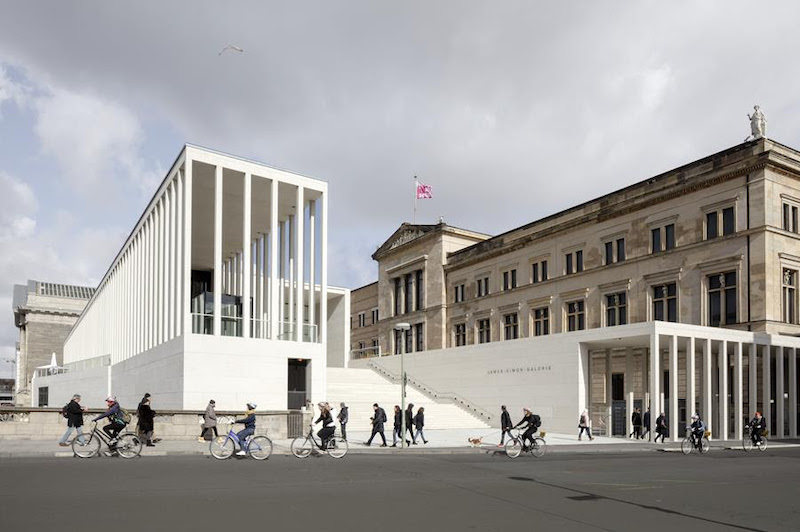The James-Simon-Galerie, the first new building on Berlin’s Museum Island in nearly 100 years, opened to the public on July 13, 2019 and acts as the new entrance building to the island. The building sits at a key location in front of or behind the Neues Museum and Pergamon Museum, complementing the interplay of spatial alignments on the island and reorientating it towards the city.
The project plays an essential role in the Museum Island master plan and links four of the five museums via the Archaeological promenade below ground (the project includes 3 above ground levels, one mezzanine, and two below ground levels). The master plan sets a framework for developing a modern museum complex while preserving the unique historical ensemble, and the James-Simon-Galerie does just that by providing a contemporary aesthetic that blends in with the surrounding museums.
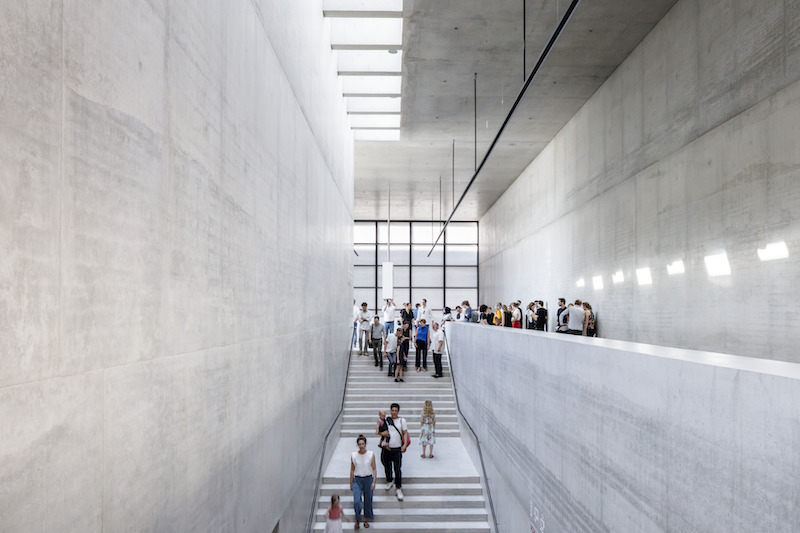 Upper foyer, main internal staircase. Photo: © Ute Zscharnt for David Chipperfield Architects.
Upper foyer, main internal staircase. Photo: © Ute Zscharnt for David Chipperfield Architects.
The primary façade material is cast stone. An aggregate made of white marble gravel from Saxony lends the entrance building its tonality, integrating it into the diversity of materials on Museum Island. Behind the building's columns, the envelop is glazed, and stabilized by eight-meter-high vertical façade supports, themselves made from glass.
See Also: POST Houston mixed-use development will include a five-acre “skylawn”
Inside, the structure is characterized by textured surfaces, in particular smooth in-situ concrete walls in fair-face concrete and floors made of bright Crailsheim shell limestone. The mezzanine floor and the auditorium have smoked oak parquet flooring. Bronze was used for window profiles, doors and handrails throughout the building. A copper braid was used on selected ceilings, including in the café.
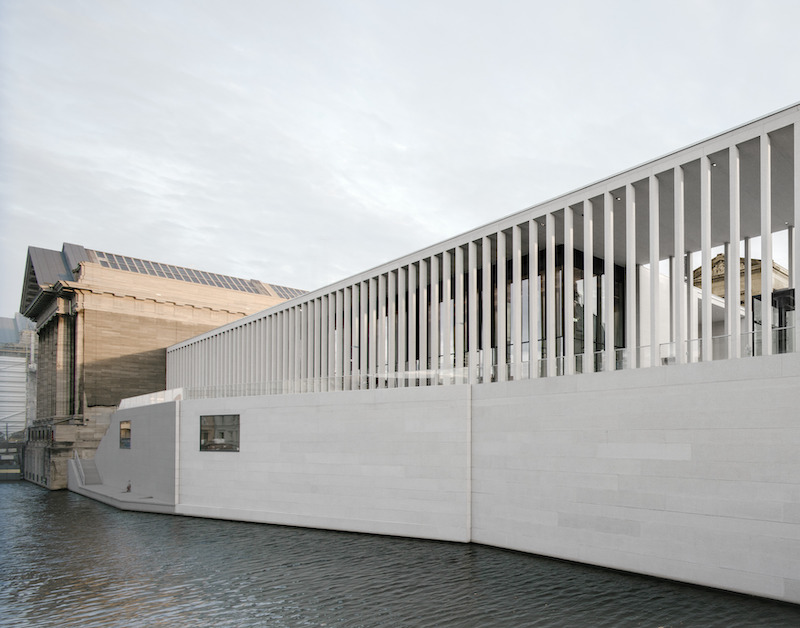 Plinth and tall colonnade (92 columns). Photo: Photo: © Simon Menges.
Plinth and tall colonnade (92 columns). Photo: Photo: © Simon Menges.
The 10,900-sm building was designed to welcome large numbers of visitors and to house all the facilities required by contemporary museum-goers. The James-Simon-Galerie also includes divisible temporary exhibition space and a 350-seat auditorium. Outside of museum hours, a grand staircase, a terrace with café, and a new courtyard will be accessible to the public.
Revolving doors and draft lobbies help minimize heat loss despite the expected high frequency of visitors. The use of radiant building components implemented in the plant technology of the building uses thermally activated surfaces to cover the base load in heating and cooling, reducing the air volume flows. A thermally active and acoustically absorbent ceiling with a copper mesh cladding, which was used in selected areas, also has a positive effect.
Museum Island has been a UNESCO World Heritage site since 1999 and is visited by about three million people every year.
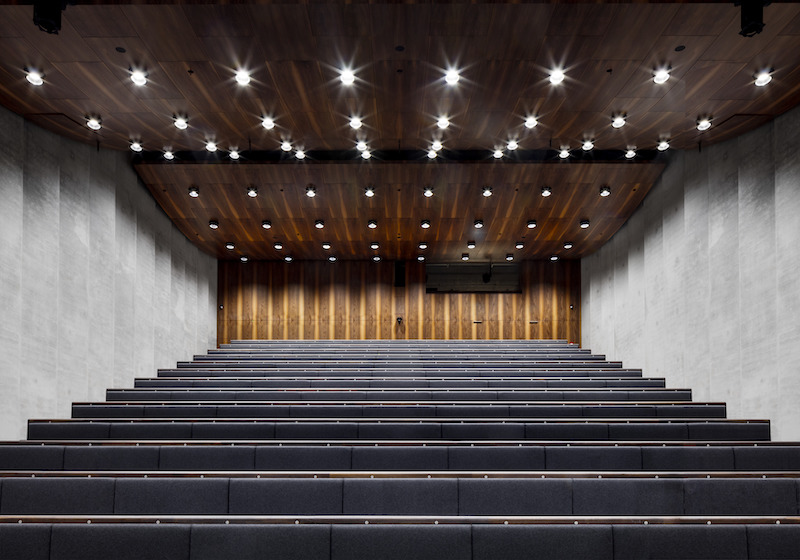 Auditorium. Photo: © Ute Zscharnt for David Chipperfield Architects.
Auditorium. Photo: © Ute Zscharnt for David Chipperfield Architects.
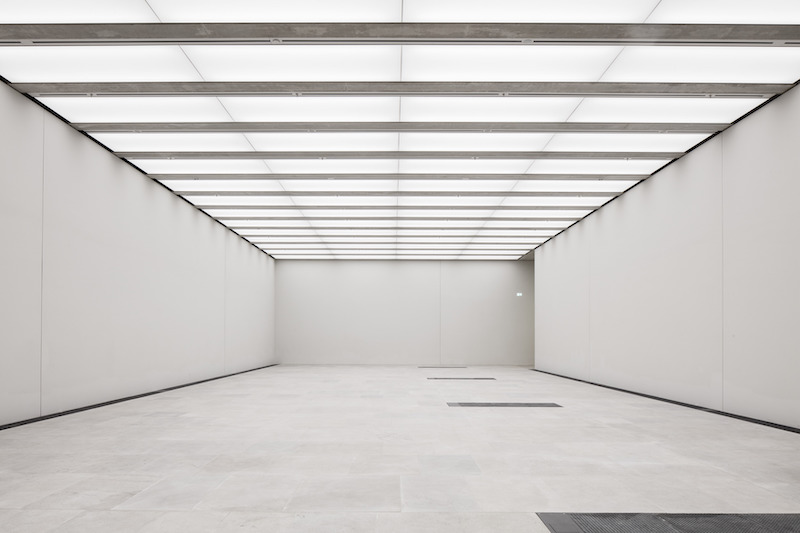 Temporary exhibition space. Photo: © Ute Zscharnt for David Chipperfield Architects.
Temporary exhibition space. Photo: © Ute Zscharnt for David Chipperfield Architects.
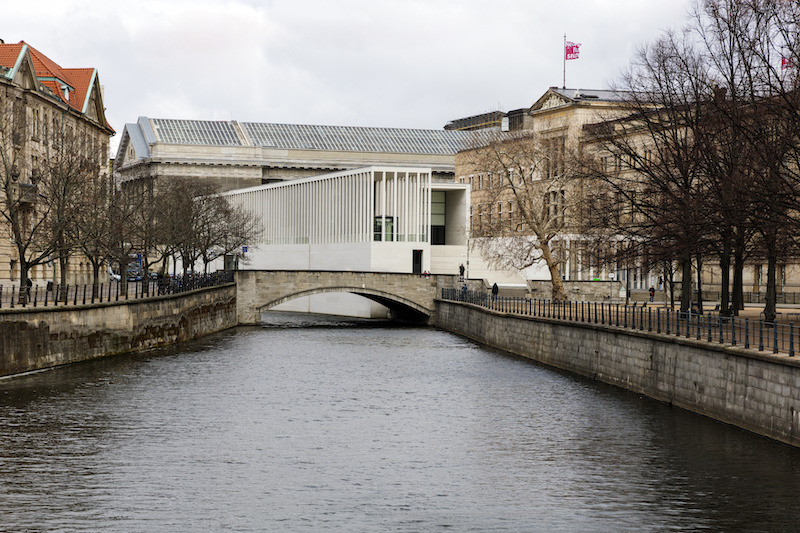 View from Schlossbrücke. Photo: © Ute Zscharnt for David Chipperfield Architects.
View from Schlossbrücke. Photo: © Ute Zscharnt for David Chipperfield Architects.
Related Stories
| Sep 12, 2011
Living Buildings: Are AEC Firms up to the Challenge?
Modular Architecture > You’ve done a LEED Gold or two, maybe even a LEED Platinum. But are you and your firm ready to take on the Living Building Challenge? Think twice before you say yes.
| Apr 13, 2011
Expanded Museum of the Moving Image provides a treat for the eyes
The expansion and renovation of the Museum of the Moving Image in the Astoria section of Queens, N.Y., involved a complete redesign of its first floor and the construction of a three-story 47,000-sf addition.
| Apr 12, 2011
Entrance pavilion adds subtle style to Natural History Museum of Los Angeles
A $13 million gift from the Otis Booth Foundation is funding a new entrance pavilion at the Natural History Museum of Los Angeles County. CO Architects, Los Angeles, is designing the frameless structure with an energy-efficient curtain wall, vertical suspension rods, and horizontal knife plates to make it as transparent as possible.
| Jan 21, 2011
Sustainable history center exhibits Fort Ticonderoga’s storied past
Fort Ticonderoga, in Ticonderoga, N.Y., along Lake Champlain, dates to 1755 and was the site of battles in the French and Indian War and the American Revolution. The new $20.8 million, 15,000-sf Deborah Clarke Mars Education Center pays homage to the French magasin du Roi (the King’s warehouse) at the fort.
| Jan 19, 2011
Industrial history museum gets new home in steel plant
The National Museum of Industrial History recently renovated the exterior of a 1913 steel plant in Bethlehem, Pa., to house its new 40,000-sf exhibition space. The museum chose VOA Associates, which is headquartered in Chicago, to complete the design for the exhibit’s interior. The exhibit, which has views of five historic blast furnaces, will feature artifacts from the Smithsonian Institution to illustrate early industrial America.
| Jan 19, 2011
Museum design integrates Greek history and architecture
Construction is under way in Chicago on the National Hellenic Museum, the nation’s first museum devoted to Greek history and culture. RTKL designed the 40,000-sf limestone and glass building to include such historic references as the covered walkway of classical architecture and the natural wood accents of Byzantine monasteries. The museum will include a research library and oral history center, plus a 3,600-sf rooftop terrace featuring three gardens. The project seeks LEED Silver.
| Nov 23, 2010
The George W. Bush Presidential Center, which will house the former president’s library
The George W. Bush Presidential Center, which will house the former president’s library and museum, plus the Bush Institute, is aiming for LEED Platinum. The 226,565-sf center, located at Southern Methodist University, in Dallas, was designed by architect Robert A.M. Stern and landscape architect Michael Van Valkenburgh.
| Nov 2, 2010
Cypress Siding Helps Nature Center Look its Part
The Trinity River Audubon Center, which sits within a 6,000-acre forest just outside Dallas, utilizes sustainable materials that help the $12.5 million nature center fit its wooded setting and put it on a path to earning LEED Gold.
| Oct 13, 2010
Tower commemorates Lewis & Clark’s historic expedition
The $4.8 million Lewis and Clark Confluence Tower in Hartford, Ill., commemorates explorers Meriwether Lewis and William Clark at the point where their trek to the Pacific Ocean began—the confluence of the Mississippi and Missouri Rivers.
| Oct 12, 2010
Gartner Auditorium, Cleveland Museum of Art
27th Annual Reconstruction Awards—Silver Award. Gartner Auditorium was originally designed by Marcel Breuer and completed, in 1971, as part of his Education Wing at the Cleveland Museum of Art. Despite that lofty provenance, the Gartner was never a perfect music venue.


